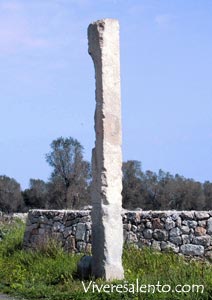|
|

| Inhabitants' name: Giuggianellesi |
The civic coat of arms
of Giuggianello is marked by a background with white and red horizontal strips
 where
there is a jujube. The human presence on the territory during the prehistory is
proved by the recovery of Neolithic vases and human skeletons in the Cave of the
Madonna of the Serra. Nearby there are some megalithic monuments like the
menhir "Crocecaduta" and the menhir "Polisano", four meters tall. Its name
might come from an ancient wood of jujubes, but according to an other hypothesis
it derives from that of a Roman centurion, Giugianus, who probably founded it
(after having won this land for his courage on the battleground). He made his
own house and that of his soldiers build and, the village became more and more
crowded. According to Arditi and Masselli, the first village was built in the X
century by the people who had escaped from the destruction of the near Casale
of Muro, that was razed to the ground by the Saracens. The feudal age started
after the arrival of the Norman king Tancredi Of Altavilla, that incorporated
the centre into the County of Lecce. Later it was annexed to the Principality of
Taranto and it was first governed by the Orsini del Balzos and then by the
Lubellis, the Martinos, the Basurtos and the Guarinis. The last feudal vassals
were the Veris, that ruled it until 1806. One of the most important native
characters is Domenico Pirtoli. He lived between the XVII and the XVIII
centuries and, after graduating in Law in 1718, he was appointed Vicar of the
Diocese of Castro and then Canon at the Archbishop's Palace of Otranto. where
there is a jujube. The human presence on the territory during the prehistory is
proved by the recovery of Neolithic vases and human skeletons in the Cave of the
Madonna of the Serra. Nearby there are some megalithic monuments like the
menhir "Crocecaduta" and the menhir "Polisano", four meters tall. Its name
might come from an ancient wood of jujubes, but according to an other hypothesis
it derives from that of a Roman centurion, Giugianus, who probably founded it
(after having won this land for his courage on the battleground). He made his
own house and that of his soldiers build and, the village became more and more
crowded. According to Arditi and Masselli, the first village was built in the X
century by the people who had escaped from the destruction of the near Casale
of Muro, that was razed to the ground by the Saracens. The feudal age started
after the arrival of the Norman king Tancredi Of Altavilla, that incorporated
the centre into the County of Lecce. Later it was annexed to the Principality of
Taranto and it was first governed by the Orsini del Balzos and then by the
Lubellis, the Martinos, the Basurtos and the Guarinis. The last feudal vassals
were the Veris, that ruled it until 1806. One of the most important native
characters is Domenico Pirtoli. He lived between the XVII and the XVIII
centuries and, after graduating in Law in 1718, he was appointed Vicar of the
Diocese of Castro and then Canon at the Archbishop's Palace of Otranto.
|